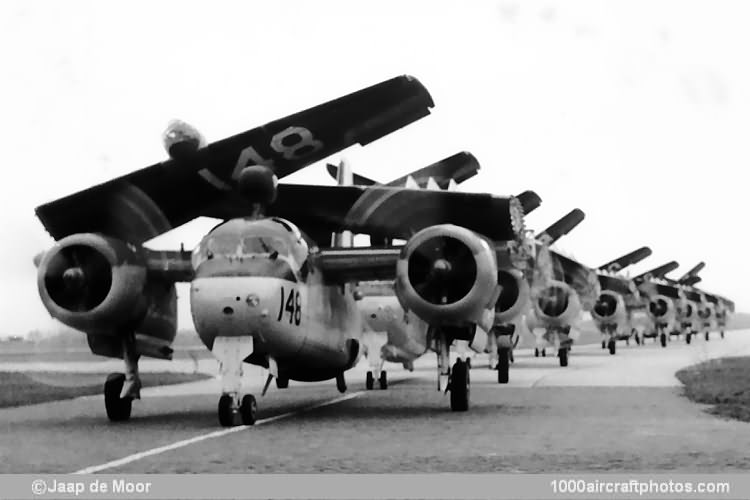06/30/2010. Remarks by Johan Visschedijk: "The advent of missile-armed nuclear submarines had significant and far-reaching effects upon the nature and number of aircraft employed for anti-submarine duties. The key to defense against submarines is the ability to detect their presence, and the development of a range of sophisticated new detection equipment placed new demands upon the aircraft which carried it. At the same time, new weapons appeared, including air-to-underwater guided missiles, which had to be accommodated together with associated electronic systems.
These processes soon rendered out of date the anti-submarine hunter-killer teams of the immediate post-war years, such as the TBM-3S/TBM-3W Avenger and AF-2S/AF-2W Guardian. To succeed them, the USN initiated on June 30, 1950, a program to produce a new type combining both roles, anti-submarine search and strike, in one airframe. Key requirements were the ability to carry all the necessary weapons and equipment plus fuel for long search missions at low altitude, in an airplane suitable for operation from carrier decks.
The USN's choice to meet its specification was the G-89 of the Grumman Aircraft Engineering Corporation (Bethpage, New York, USA), a high-wing monoplane powered by two 1,525 hp Wright R-1820-82WA piston engines. Detection equipment included APS-38 search radar in a retractable radome in the rear fuselage, a 70-million candlepower searchlight on the starboard wing and an ASQ-10 magnetic anomaly detector in a retractable fairing in the rear fuselage.
A fuselage bay could store one depth-bomb or two torpedoes, and bays in the rear of the engine nacelles carried eight sono-buoys each. Additional weapons or stores, like depth-bombs, torpedoes or rockets, could be carried on three strong points under each wing.
When first ordered, the prototype was designated XS2F-1, but all aircraft in the S2F Tracker series were redesignated in the S-2 series in 1962. The first flight was made at Bethpage by test pilots Fred Rowley and Norm Coutant on December 4, 1952, and the first production S2F-1 (later S-2A) entered service with Anti-Submarine Squadron VS-26 in February 1954. Production of this version totaled 650, including over 100 supplied to foreign nations under the MAP arrangements.
Post-delivery modifications produced a number of S2F-1T (later TS-2A) for use by training squadrons, over 50 US-2A target tugs to replace the Navy's UB-26Js, and a quantity of S2F-1S (later S-2B), which differed from the S2F-1 in having AQA-3 Jezebel passive long-range acoustic search equipment and its associated Julie explosive echo-sounding equipment.
Sixty S2F-2 (later S-2C) delivered in 1954-1955 had enlarged bomb-bays in order to carry a new type of homing torpedo, and the tail surfaces were enlarged to match the higher operating weights. A few of this batch, with cameras, were designated S2F-2P (later RS-2C), and others used on utility duties were S2F-2U (later US-2C).
The second major production version of the Tracker was the S2F-3 (later S-2D), first flown on May 21, 1959. This had an enlarged front fuselage to improve working space and comfort for the two pilots and two radar operators; the span was increased, tail surfaces enlarged, fuel capacity increased and engine nacelles modified to carry sixteen instead of eight sono-buoys each.
Operational use of the S2F-3 began in May 1961, and the S-2E followed a little later, this being the S2F-3 with Julie/Jezebel equipment and a tactical navigation system. More than 300 S-2Ds and S-2Es were built and at least eighteen USN squadrons flew them.
Final up-dating of the early S-2Bs with the Julie/Jezebel installation resulted in the S2F-1S1 (later S-2F). Later utility conversions of the S-2A with some features of the S-2B/S-2F became US-2Bs.
Under the MDAP, the MLD of the RNethN received between March 8, 1960 and January 12, 1961, 26 Grumman S2F-1 Trackers, s/n 146 to 171, while an additional two, s/n 172 and 173, were delivered on March 30, 1962. The aircraft were assigned to No. 4 Squadron, based at the carrier Hr.Ms. 'Karel Doorman' (R81), and to No. 1, 5 and 320 Squadron, based at the NAS Valkenburg, near Leiden, the Netherlands.
Between December 6, 1960 and September 18, 1961, the MLD received seventeen CS2F-1 Trackers, s/n 180 to 196, bought from the Canadian Navy. Most of them were assigned to No. 65 Squadron at Hato, Curacao, West Indies, while five were assigned to No. 4 Squadron at the HMS 'Karel Doorman'. The CS2F-1s were withdrawn from use from May 13, 1968 on, the last on August 1, 1971.
Eighteen S2F-1 Tracker were upgraded to S-2N configuration in 1969-1970, eight were transferred via US MAAG (Military Assistance Advisory Group) to the Turkish Navy. Eventually, four S-2Ns were converted to US-2Ns, the MAD boom and equipment were removed and the type was used for target towing. From February 1974 on, the S-2Ns were gradually withdrawn from use.
The pictured '148' was produced for the MLD under the USN BuNo. 147638 and delivered on April 7, 1960. It was one of at least seventeen S2F-1 Trackers that have served aboard the HMS 'Karel Doorman', and is seen here at NAS Valkenburg leading a pack of eight aircraft to be transferred to the carrier. The aircraft was withdrawn from service December 31, 1971, and subsequently delivered to the Turkish Navy, were it received the serial
TCB-148.
The Trackers could be launched using the steam catapult, or take off under own power, seen here with rockets on the hard points. For landing on the carrier the MLD Trackers could made use of the CCA (Carrier Controlled Approach) procedure, in which the aircraft was 'talked' aboard by a controller using the CCA radar, just visible to the left and halfway up of the superstructure in the fourth of these five photos."
